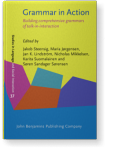Chapter 2
On granularity in grammar and action
In this study, we explore the relevance of granularity to
the study of grammar-in-interaction, with special reference to the
writing of an online grammar (cf. Steensig, et al. 2023). In CA/IL research, it routinely
occurs that a form or action is described and analyzed at one level
of detail, and then subsequent research reveals that that
form/action actually displays meaningful and ordered variation that
deserves more focused examination. Here we summarize previous
studies which reveal the significance of more granular descriptions,
and we discuss our maxim — arising from Sacks’ claim that there is
‘order at all points’ — that the more granular our analytic
approaches are, the more granular our understandings of forms and
actions will become.
Article outline
- 1.Introduction
- 2.Granularity in the study of a particle: The case of
oh
- 3.Granularity in the study of clause beginnings: The case of
((do) you) want…
- 4.Granularity in the study of clause endings: The case of
The Problem with ‘X’
- 5.Discussion: What is ‘grammar’, and what is ‘action’?
- 5.1What is ‘grammar’?
- 5.2What is ‘action’?
- 5.3How to incorporate granularity into written grammars
- 6.Conclusion
-
Notes
-
References
This content is being prepared for publication; it may be subject to changes.
